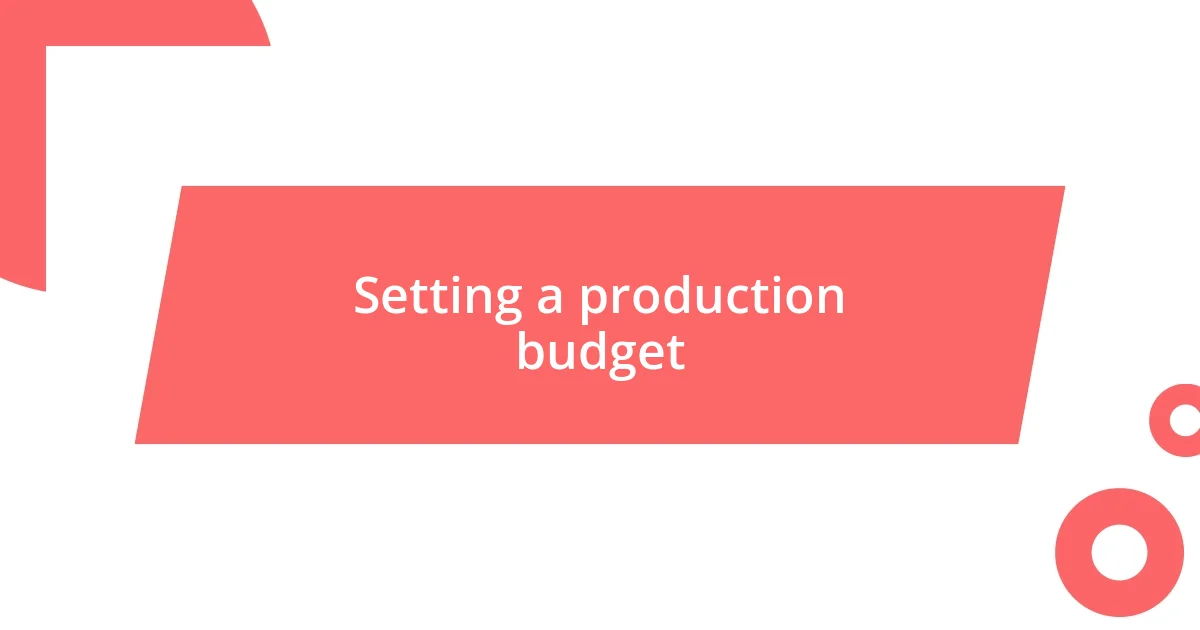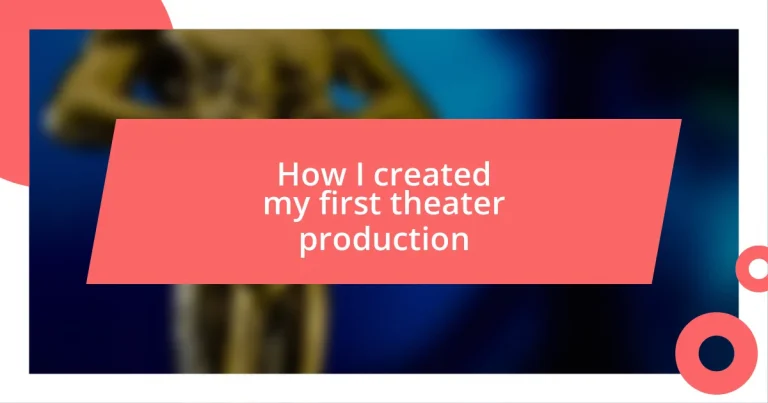Key takeaways:
- Choosing a play that resonates emotionally with the cast and crew is crucial for a successful production.
- Assembling a creative team requires careful consideration of skills, shared vision, and fostering a cohesive atmosphere to avoid conflicts.
- Effective marketing and thorough budget planning are essential to successfully promote the production and manage resources, ultimately enhancing the production’s reach and impact.

Choosing the right play
Choosing the right play for your first theater production is a critical step that can set the tone for your entire project. I still remember sifting through scripts and feeling that electric rush of excitement mixed with uncertainty. How do you know which play will resonate with your cast, crew, and audience?
Once, I was torn between a classic and a modern piece. The classic had a well-established reputation but felt somewhat distant from the issues I wanted to tackle. The contemporary option sparked conversations about current events and elicited genuine excitement from my team. Reflecting on this experience, I’ve realized that the emotional connection a play fosters is just as vital as its content. What themes do you want to explore?
Ultimately, I learned that considering the strengths and interests of your cast can be just as important as the script itself. I discovered that when actors feel connected to the material, their performances blossom. So, ask yourself: what play can ignite that passion in your team? The right choice can transform your production, bringing it to life in ways you never imagined.

Gathering a creative team
Gathering the right creative team for your production is like assembling a puzzle. Each member brings unique skills, perspectives, and energy to the table. I found that my first step was reaching out to people whose work I admired. I still remember attending a friend’s showcase and feeling that spark of inspiration when I saw them perform; that’s when I approached them about being part of my project. I realized the importance of surrounding myself with individuals who share a similar creative vision and work ethic.
The next challenge was assessing the diverse talents each person could contribute. While one might excel in choreography, another shines in set design. I organized a casual brainstorming session over coffee, which allowed everyone to express their ideas freely. This approach not only fostered open communication but also led to exciting collaborations I hadn’t initially envisioned. The excitement was palpable as we exchanged ideas, creating a sense of camaraderie that would be crucial throughout the production process.
It’s essential to establish a cohesive atmosphere from the start. I learned the hard way that mismatched energies can lead to misunderstandings and frustration. In my first production, there was a moment when two team members clashed creatively, causing tension. To move past this, I facilitated an open discussion where each could share their vision and concerns. This experience taught me that not only is talent important, but so is compatibility. Overall, approaching the gathering of a creative team thoughtfully sets the foundation for a harmonious and successful production.
| Aspect | Importance |
|---|---|
| Skills | Different talents enhance overall creativity |
| Vision | Shared goals foster collaboration |
| Cohesion | Compatibility reduces conflict |

Setting a production budget
Setting a production budget can feel daunting, but I found it to be a crucial step in bringing my vision to life. During my first production, I made the rookie mistake of underestimating the costs associated with renting the venue and purchasing necessary supplies. The surprise expenses nearly derailed my plans. To avoid this pitfall, I highly recommend creating a detailed expense list. This way, you can visualize your spending and adjust accordingly.
Here are some key elements to consider while setting your budget:
- Venue Costs: Rental fees, deposits, and any additional charges for equipment.
- Casting and Crew Fees: Salaries or stipends for actors, directors, and other creatives.
- Materials: Cost of costumes, props, and set construction supplies.
- Marketing: Budget for posters, flyers, and online promotions.
- Rehearsal Expenses: Potential costs for extra rehearsal space or equipment needs.
Breaking these elements down not only helps you stay organized but also forces you to confront harsh realities about what’s feasible. Watching the numbers come together gave me a clearer picture of what my production could achieve and helped reignite my excitement for the project. I’ve learned that transparency in budgeting translates to a smoother production journey.

Planning the rehearsal schedule
Planning a rehearsal schedule is an art in itself. I vividly remember sitting at my kitchen table, a huge calendar spread out in front of me. My initial thought? How on earth am I going to fit everyone’s availability into a cohesive plan? I started by gathering everyone’s schedules—this simple act made me realize the importance of flexibility. Some actors had day jobs while others juggled classes. The key was prioritizing essential rehearsals while also keeping everyone motivated and engaged.
As I pieced together the timetable, I found it helpful to both block out time for larger group rehearsals and leave room for individual practice. Trust me, there’s magic in those solo moments when an actor can really dig into their character without distractions. I made sure to include breaks during long rehearsals, understanding that those moments not only recharge energy but also spark spontaneous creative ideas with the whole team. Have you ever noticed how a quick chat during a break can lead to a brilliant concept that you hadn’t thought of before?
I discovered that consistency in rehearsal times created a sense of commitment among my cast. It was like building a routine that everyone relied on. However, challenges arose, just as they always do in theater. One week, several actors couldn’t make it due to conflicting events. So, I quickly adapted by scheduling a couple of extra sessions to catch up on lost time without compromising quality. This experience taught me that a rehearsal schedule isn’t just a timeline; it’s a living document that must evolve to fit the needs of the production and to keep the creative energy flowing.

Marketing your theater production
Marketing a theater production is an adventure that blends creativity with strategy. I remember the excitement I felt when I started brainstorming ideas for posters and social media campaigns. I discovered that visuals play a huge role in attracting an audience. Have you ever been drawn in by an intriguing image or a catchy slogan? It’s powerful! Collaborating with a graphic designer to create eye-catching materials not only showcased our production but also sparked interest within our community.
Engaging with potential audiences is just as crucial as the visuals. I found that hosting pre-show events or sneak previews helped create buzz. One of my clearest memories is inviting local influencers to a rehearsal. Their enthusiasm not only brought additional eyes to our production but also created a sense of community support. Have you considered how word of mouth can amplify your marketing efforts? Social interactions can elevate the excitement and create advocates who’ll spread the word well beyond your immediate circle.
Finally, I learned the importance of utilizing online platforms to reach a broader audience. Setting up a dedicated website and leveraging social media meant that I could connect with fans directly. I had moments where I felt overwhelmed by the digital landscape, but the engagement I witnessed on platforms like Instagram was so rewarding. People shared their excitement about the show, often tagging us in their posts, which created a sense of anticipation. It’s this kind of connection that turns a simple production into an event that people remember and want to be a part of. Have you ever thought about how digital marketing could transform your production’s reach?

Opening night preparations
As opening night approached, the atmosphere was electric with both excitement and nerves. I found myself organizing last-minute details, from stage setups to costume checks, while keeping a close eye on the clock. It’s wild how everything seems to come rushing in at once—have you ever felt that sense of urgency that makes the adrenaline surge?
One particular moment stands out in my memory: just hours before the show, I gathered the cast for a pep talk. Standing in a circle, with the warmth of their camaraderie surrounding us, I felt an overwhelming sense of gratitude. We shared our hopes for the performance, and I could see the same flicker of excitement reflected in their eyes. It reminded me of how collaboration in theater creates a unique bond—there’s something magical about sharing a dream with a group of passionate individuals.
Before the curtain rose, I made it a point to check in with each member of the team. The vulnerability of artists is palpable right before a show. I’ve learned that a simple, heartfelt encouragement can mean the world. Has there ever been a moment in your life when a word of support shifted your mindset? In that fleeting time before our first audience arrived, I truly understood the power of unity among us, lifting one another together for what would soon unfold.

Reflecting on the experience
Reflecting on the experience, I can’t help but marvel at how much I’ve grown throughout this journey. I remember feeling naïve about the complexities of production; every mishap, from a missing prop to miscommunication with the cast, became a lesson in adaptability. How often do we find ourselves unprepared for challenges, yet emerge more resilient? It’s a transformative realization that truly fuels my passion for theater.
Diving deeper into those moments, I realize that the relationships formed during this production were just as critical as the performances themselves. I learned to value honest feedback and constructive criticism—not just from my peers, but from myself. I recall a particularly tough rehearsal where I had to acknowledge my shortcomings; instead of feeling defeated, it sparked a desire to improve, pushing me to dig deeper into my own creative well. Isn’t it fascinating how vulnerability can lead to personal growth?
Looking back, I often find myself drawn to the sheer joy of the finale. The applause felt like a warm embrace, rewarding all our hard work. Those fleeting seconds after the last bow, when I caught my cast’s jubilant expressions, encapsulated a euphoric mix of exhaustion and fulfillment. It continually reminds me of why I’m in this field—despite the hurdles, we create something beautiful, and that’s what I’ll always cherish. Have you ever had a moment where all your efforts coalesced into pure happiness? It’s a sensation worth striving for again and again.














